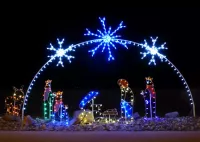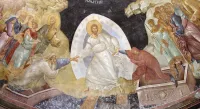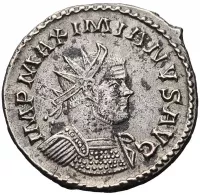Rudolph the Red-Nosed Reindeer, created by Robert L. May, is a fictional reindeer known for his bright red nose. Often depicted as the youngest of Santa Claus's reindeer, Rudolph uses his nose to guide Santa's sleigh on Christmas Eve. Initially ridiculed for his unusual nose, its powerful luminescence proves crucial in navigating difficult winter weather, making him a celebrated member of the team. Rudolph's story resonates with children as it embodies the theme of self-acceptance and celebrating individuality, mirroring the American Dream narrative.
1930: Cultural Context of a Red Nose
In the 1930s, a red nose was often associated with alcoholism. This cultural context initially led to the rejection of May's Rudolph story idea. Denver Gillen's illustrations of a "cute reindeer" ultimately convinced management to support the project.
1939: Rudolph's First Appearance
In 1939, Rudolph the Red-Nosed Reindeer made his debut in a booklet written by Robert L. May and published by Montgomery Ward.
1939: Rudolph's Creation
Robert L. May created Rudolph in 1939 as an assignment for Montgomery Ward. The retailer sought a cost-effective alternative to buying coloring books for Christmas giveaways. May drew inspiration from his daughter's fondness for deer and his own childhood experiences.
1947: First Mass-Market Edition
Maxton Books published the first mass-market edition of Rudolph the Red-Nosed Reindeer in 1947.
1948: First Screen Appearance
Rudolph made his first screen appearance in a 1948 cartoon short produced by Max Fleischer for the Jam Handy Corporation. This version stayed true to May's original story.
1949: Hit Song
Johnny Marks, Robert L. May's brother-in-law, adapted the Rudolph story into a song. Gene Autry's recording of the song reached No. 1 on the Billboard pop singles chart during Christmas week in 1949.
August 1, 1950: View-Master Release
A View-Master version of Rudolph the Red-Nosed Reindeer, created by Sawyer's, was released on August 1, 1950. It featured text by Thomas L. Dixon and model work by Florence Thomas.
1950: DC Comics Series Begins
DC Comics (then National Periodical Publications) began publishing a series of Rudolph the Red-Nosed Reindeer annuals in 1950, with illustrations primarily by Rube Grossman.
1951: Reissue with Song
The 1948 Rudolph cartoon short was reissued in 1951 with the addition of Johnny Marks' song.
1954: Sequel Publication
"Rudolph the Red-Nosed Reindeer Shines Again," a sequel to the original story, was published in 1954.
September 10, 1955: View-Master Sequel Release
A three-reel View-Master packet featuring new Rudolph stories by Robert L. May was released on September 10, 1955. Florence Thomas again contributed to the project.
1958: Little Golden Books Publication
Little Golden Books published an illustrated storybook adaptation of Rudolph the Red-Nosed Reindeer by Barbara Shook Hazen and Richard Scarry in 1958.
1962: DC Comics Series Ends
The initial run of DC Comics' Rudolph the Red-Nosed Reindeer annuals concluded in 1962.
1969: Frosty the Snowman Original Special
Rankin/Bass' adaptation of Frosty the Snowman was initially released in 1969, laying the groundwork for the later crossover with Rudolph.
1970: Rudolph Cameo in Santa Claus is Comin' to Town
Rudolph made a cameo appearance in the 1970 "Animagic" special "Santa Claus is Comin' to Town."
1972: Revised Little Golden Books Edition
A revised Little Golden Books version of the Rudolph storybook was reissued in 1972.
1972: DC Comics Publishes Extra-Large Format
In 1972, DC Comics published a 14th edition of Rudolph the Red-Nosed Reindeer in an extra-large format, followed by six more in the same format.
1976: Rudolph's Shiny New Year and The First Easter Rabbit Released
In 1976, two films featuring Rudolph were released: "Rudolph's Shiny New Year," a sequel to the original special, and "The First Easter Rabbit," an Easter special with cel animation by Topcraft.
1977: Rudolph Cameo in Nestor, the Long-Eared Christmas Donkey
Rudolph made another cameo appearance in the 1977 "Animagic" special "Nestor, the Long-Eared Christmas Donkey."
1979: Rudolph and Frosty's Christmas in July Released
The Rudolph series expanded in 1979 with the release of "Rudolph and Frosty's Christmas in July," a feature-length film that combined the Rudolph and Frosty the Snowman universes.
April 1980: Digest Format Edition Published
A digest format edition of Rudolph the Red-Nosed Reindeer was published as "The Best of DC #4" in April 1980. The 1970s Rudolph stories were created by Sheldon Mayer.
1992: Unpublished Sequel Release
In 1992, Applewood Books published "Rudolph's Second Christmas," an unpublished sequel written by Robert L. May in 1947.
1998: Rudolph the Red-Nosed Reindeer: The Movie Released
"Rudolph the Red-Nosed Reindeer: The Movie," a 2D-animated feature film by GoodTimes Entertainment and Golden Books Family Entertainment, had a limited theatrical release in 1998 before going to home video. It featured new characters inspired by the Rankin/Bass special.
2001: Rudolph the Red-Nosed Reindeer and the Island of Misfit Toys Released
In 2001, GoodTimes Entertainment released the CGI-animated sequel "Rudolph the Red-Nosed Reindeer and the Island of Misfit Toys," featuring the original Rankin/Bass characters due to a copyright discovery.
2003: Reprint with New Artwork
Penguin Books issued a reprint version of the original "Rudolph the Red-Nosed Reindeer" with new artwork by Lisa Papp in 2003. Penguin also reprinted May's sequels.
November 6, 2014: 75th Anniversary and Postage Stamps
On November 6, 2014, the 75th anniversary of Rudolph's creation and the 50th anniversary of the Rankin/Bass television special were celebrated. The United States Postal Service issued a series of postage stamps featuring Rudolph.
December 25, 2014: Rudolph Appears in Doctor Who Christmas Special
On December 25, 2014, a live-action version of Rudolph, along with Donner and Blitzen, appeared in the Doctor Who Christmas special "Last Christmas."
2015: Scholarly Paper Published on Rudolph's Red Nose
Dartmouth College professor Nathaniel Dominy published a paper in 2015 exploring the science behind Rudolph's red nose, suggesting its potential advantages in foggy conditions.
2019: Freeform Airings
The Rankin/Bass special began airing on Freeform's "25 Days of Christmas" in 2019.
2034: Copyright Expiration
The copyright for the first mass-market edition of Rudolph the Red-Nosed Reindeer will expire in 2034.
Mentioned in this timeline
CBS Broadcasting Inc CBS is a prominent American commercial broadcast...

Christmas is an annual festival celebrated on December th commemorating...
The National Broadcasting Company NBC is a major American commercial...
Doctor Who a British science fiction series by the BBC...

Easter is a Christian holiday celebrating the resurrection of Jesus...

Santa Claus is a legendary figure in Western Christian culture...
Trending
16 days ago Anthropic CEO to testify on Chinese AI cyberattack; Chatbots becoming criminals.

6 months ago Kash Patel, FBI Director, entangled in 2020 election conspiracy probe.

2 months ago Gwyneth Paltrow on Timothée Chalamet and Kylie Jenner's Relationship: 'Punk Rock'

Lisa Rinna is an American actress television personality and model known for her roles on soap operas like Days of...
8 months ago Barcelona and Real Madrid to Clash in Copa del Rey Final El Clasico.

5 months ago Student Loan Repayment Troubles: 460K Denied, Backlog Alarms, Forgiveness Halted.
Popular

Candace Owens is an American conservative political commentator and author...

Ilhan Omar is an American politician currently serving as the...

XXXTentacion born Jahseh Dwayne Ricardo Onfroy was a controversial yet...

Frederick Christ Trump Sr - was an American real estate...

Charles James Charlie Kirk was a prominent American right-wing political...

Cristiano Ronaldo often nicknamed CR is a Portuguese professional footballer...